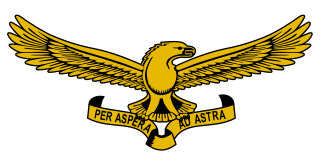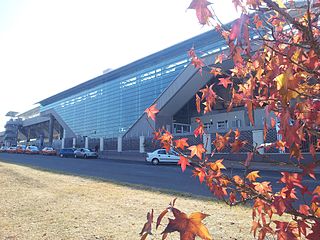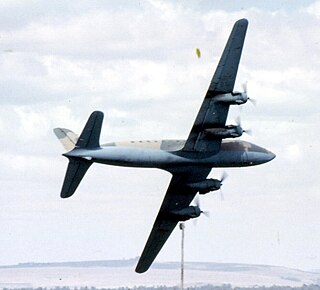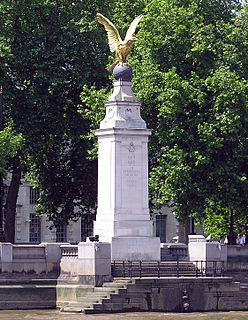
Pretoria is one of South Africa's three capital cities, serving as the seat of the executive branch of government, and as the host to all foreign embassies to South Africa. Cape Town is the legislative capital whereas Bloemfontein is the judicial capital.

The British Commonwealth Air Training Plan (BCATP), or Empire Air Training Scheme (EATS) often referred to as simply "The Plan", was a massive, joint military aircrew training program created by the United Kingdom, Canada, Australia and New Zealand, during the Second World War. BCATP remains as one of the single largest aviation training programs in history and was responsible for training nearly half the pilots, navigators, bomb aimers, air gunners, wireless operators and flight engineers who served with the Royal Air Force (RAF), Royal Navy Fleet Air Arm (FAA), Royal Australian Air Force (RAAF), Royal Canadian Air Force (RCAF) and Royal New Zealand Air Force (RNZAF) during the war.

The Union Buildings form the official seat of the South African Government and also house the offices of the President of South Africa. The imposing buildings are located in Pretoria, atop Meintjieskop at the northern end of Arcadia, close to historic Church Square and the Voortrekker Monument. The large gardens of the Buildings are nestled between Government Avenue, Vermeulen Street East, Church Street, the R104 and Blackwood Street. Fairview Avenue is a closed road through which only officials can enter the Union Buildings. Though not in the centre of Pretoria, the Union Buildings occupy the highest point of Pretoria, and constitute a South African national heritage site.

The South African Air Force (SAAF) is the air warfare branch of South African National Defence Force, with its headquarters in Pretoria. The South African Air Force was established on 1 February 1920. The Air Force saw service in World War II and the Korean War. From 1966, the SAAF was involved in providing infantry support in the low-intensity Border War in Angola, South-West Africa and Rhodesia. As the war progressed, the intensity of air operations increased, until in the late 1980s when the SAAF were compelled to fly fighter missions against Angolan aircraft in order to maintain tactical air superiority. On conclusion of the Border War in 1990, aircraft numbers were severely reduced due to economic pressures as well as the cessation of hostilities with neighbouring states.

Centurion is an area with 236,580 inhabitants in the Gauteng Province of South Africa, between Pretoria and Midrand (Johannesburg). Formerly an independent municipality, with its own town council, it has been part of the City of Tshwane Metropolitan Municipality since 2000. Its heart is at the intersection of the N1 and N14 freeways. The R21 freeway also passes through the eastern part of Centurion.

17 Squadron SAAF is a squadron of the South African Air Force. It is currently a transport/utility helicopter squadron.

19 Squadron SAAF is a current squadron of the South African Air Force operating as a transport/utility helicopter squadron. It was formed in 1939 as part of the Air Force airways Wing, flying transport aircraft but was disbanded after a few months. It was re-formed from No. 227 Squadron RAF in 1944 and disbanded again after the end of World War II. It was again re-established in 1970 as a helicopter squadron – a role which it still performs today.

44 Squadron SAAF is a squadron of the South African Air Force. It is currently a light transport squadron.

Air Force Base Waterkloof {AFB Wklf} is an airbase of the South African Air Force. It is situated on the outskirts of Pretoria, and is the SAAF's busiest airbase. The base's name, Waterkloof, is Afrikaans. It means Water Ravine in English. Despite the name, this base is not located in Waterkloof, Pretoria, but lies to the south of Pretoria, 4.34 nmi (8.04 km) to the northeast of Centurion, Gauteng and 3.37 nmi (6.24 km) from AFB Swartkop, at an elevation of 1506 metres (4940 ft).

1 Squadron SAAF was an air force squadron of the South African Air Force and was formed at Air Force Station Swartkop in February 1920, equipped with De Havilland DH.9's part of the Imperial Gift donation to South Africa by Britain. On 31 August 1939 the squadron was re-designated as 1 Bomber/Fighter Squadron and this was then changed to 11 (Bomber) Squadron in December 1939. The squadron was resurrected in February 1940 by the renumbering of 6 Squadron, equipped with four Hurricane Mk 1's and six Furies.

The Royal Air Force Memorial is a military memorial on the Victoria Embankment in central London, dedicated to the memory of the casualties of the Royal Air Force in World War I. Unveiled in 1923, it became a Grade II listed structure in 1958, and was upgraded to Grade II* in 2018. It is considered to be the official memorial of the RAF and related services.
The South African Air Force Museum houses exhibits and restores material related to the history of the South African Air Force. The museum is divided into three locations, AFB Swartkop outside Pretoria, AFB Ysterplaat in Cape Town and at the Port Elizabeth airport.

Air Force Base Swartkop is South Africa's oldest air force base and houses the South African Air Force Museum. It is managed as part of AFB Waterkloof and houses one of the three branches of the South African Air Force Museum. The name of the air force base, Swartkop means Black hill in Afrikaans.

26 Squadron SAAF is a disbanded squadron of the South African Air Force. The squadron was based at Takoradi, Gold Coast on the West Coast of Africa during World War II. They flew Vickers Wellingtons on anti-submarine and convoy escort patrols over the Atlantic. The squadron was seconded to No. 298 Wing RAF.
Kevin Roy Winterbottom was a South African Air Force (SAAF) pilot who chose to avoid crashing his stricken Impala jet aircraft in the Monument Park suburb of Pretoria by remaining with his aircraft to the end. He was posthumously awarded the 25th Honoris Crux decoration for bravery, the first such award for gallantry outside battle. The HC was at the time South Africa's highest military decoration that could be awarded in peacetime.

The Imperial Gift was the donation of aircraft from British surplus stocks after the First World War to the Dominions: Canada, Australia, New Zealand, South Africa and the Empire of India. On 29 May 1919, the British Cabinet agreed to give 100 aircraft to each of these countries plus replacements for aircraft donated by these countries to Britain during the war. These aircraft formed the core of newly established air forces in several of the countries.
The History of the South African Air Force spans the First World War, Rand Rebellion of 1922, the Second World War, the Korean War, the South African Border War, and varied peacekeeping operations since 1994. Its battle honours include German South West Africa 1914–15, German East Africa 1915–1918, East Africa: 1939–1941, Middle East: 1941–43, Madagascar 1942, Italy 1943–1945, the Balkans 1943–1945, and Korea 1950–1953.

42 Squadron SAAF is a disbanded squadron of the South African Air Force, active from 1945 to 2000. The squadron's main role was to spot enemy artillery. The unit was formed in 1945 as 42 AOP Flight, flying Austers under command of an officer of the SA Artillery and was the only army aviation unit flying for South African forces during World War II.

The Sergeant Major of the South African Air Force is the most senior Warrant Officer in the South African Air Force. The post was created in 1979. It is a singular appointment – it is only held by one person at any time. The Sergeant Major of the Air Force reports to the Chief of the Air Force and is responsible for maintaining discipline in the Air Force.
















